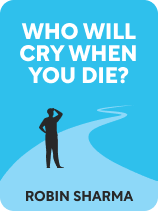

This article is an excerpt from the Shortform book guide to "Who Will Cry When You Die?" by Robin Sharma. Shortform has the world's best summaries and analyses of books you should be reading.
Like this article? Sign up for a free trial here .
Do you take enough breaks in life? Why is it so important to give yourself a break?
Robin Sharma, self-help guru and the author of Who Will Cry When You Die?, asserts that you should take intentional breaks in order to feel refreshed and energized. The three types of breaks he suggests are a weekly personal break, a short, imaginary holiday, and a one-day break from your watch.
Here’s a rundown of the different types of breaks and why it’s so important to cut yourself some slack and let things go sometimes.
Take Intentional Breaks
It’s important to give yourself a break from time to time. In his book Who Will Cry When You Die?, Sharma recommends you incorporate several types of intentional breaks in your daily life. The point of giving yourself breaks is to refresh your mind and energize you to live the rest of your day or week in service of your purpose—not to disengage from reality, for instance, by scrolling through social media feeds.
(Shortform note: In The Gifts of Imperfection, Brené Brown elaborates on the idea that we need intentional breaks in our days by introducing the acronym DIG. People who DIG are good at taking intentional breaks: They’re Deliberate in their choices of what to dedicate their energy toward, Inspired to make things better for themselves, and get Going to act on that inspiration. Applying DIG can help you more proactively take the right kind of break when you need it.)
Here are three breaks Sharma recommends:
Break #1: Weekly Personal Break
Sharma proposes building a personal break into your week. This can be a whole day or just a few hours for activities that replenish you and reconnect you to your purpose. Pick up a creative pursuit or simply an entertaining one, says Sharma. The main point is that you allow yourself to do what you want.
(Shortform note: A common counter to Sharma’s advice to take personal breaks is that you’re too busy. But while busyness is often presented as a virtue, it can also be a way to avoid difficult thoughts that might come up during breaks. For example, being “too busy” to reconnect with your purpose means you don’t have to think about how detached your life may be from it. If you constantly claim you’re too busy to take time for yourself, you might be especially in need of a personal break to reconnect to your purpose.)
Break #2: Short Imaginary Holidays as Needed
In addition to weekly breaks, take short imaginary holidays when you need a quick refresh, says Sharma. An imaginary holiday is simply a visualization of being in your favorite vacation spot, which you can do at any time during the day.
To take an imaginary holiday, writes Sharma, close your eyes and envision yourself in your favorite holiday destination. See the scenery, smell the smells, feel the atmosphere. You trick your brain into thinking you are on holiday and derive many of the same replenishing benefits.
(Shortform note: You might consider Sharma’s description of an imaginary holiday a form of self-hypnosis. In self-hypnosis, you achieve a state of focus and suggestibility and then visualize in great detail a goal you’d like to achieve, such as giving up smoking or, as Sharma suggests, relaxation. You can use self-hypnosis as a tool for improved sleep, weight loss, and even pain management. It’s important to practice self-hypnosis regularly and firmly believe in its power to get the most benefit from it.)
Break #3: One-Day Break From Your Watch
Every so often, take a one-day break from your watch or time-telling digital device, says Sharma. This puts you in tune with your personal rhythms rather than the cycle of the clock.
(Shortform note: Taking breaks from time-telling devices can help you get back into the cycle of your circadian rhythm, which ensures your body functions optimally at every moment over 24 hours. For instance, it makes your digestive system secrete proteins at mealtimes and causes sleepiness at night. Jet lag and shift work can disrupt your circadian rhythm.)
Be Okay Not Finishing Projects if They Won’t Pay Off
In addition to building regular breaks into your schedule, Sharma also advises you to take permanent breaks from projects that aren’t panning out. If you feel the outcome of a project won’t be worth the investment in it, drop it. Sharma specifically applies this advice to finishing reading books, but it can cover anything: playing in a band you don’t enjoy, volunteering with a group that’s not making a difference, or staying in a job you dislike.
| When to Abandon a Project Sharma recommends abandoning projects when you feel the costs outweigh the benefits, but it’s difficult to know when you reach this point. Ask yourself these four questions to better understand if it’s time to quit something: –Why did I originally undertake this project? If the project’s veered from its original purpose, it might be a sign you should quit. –Why do I want to quit now? Understanding your motivation to quit can help you decide if you should heed that urge or if it’s just a temporary annoyance. –Have I tried everything to make this pay off? If you haven’t done everything possible to make a project work before quitting, you might later regret it. –How will I benefit from quitting? Clarify what you’ll gain by dropping a project. Ideally, this will be time and energy to pursue more purpose-oriented ventures. |
Be Okay With Doing Nothing
Another way Sharma advises you to let go is simply by doing nothing. (This is similar to his recommendation in Tactic 6 to adopt the discipline of silence.) Sharma believes it’s in moments of inactivity that you gain distance from the chaos of regular life and can assess if you’re leading your life in service of your purpose.
(Shortform note: Sharma advocates for making time to do nothing. In our fast-paced world, this can seem like a tall order, which is why you might try the less time-consuming act of mind-wandering. Mind-wandering happens when you’re engaged in a task, but your thoughts are elsewhere. When you let your mind wander, you can do something important yet mentally undemanding—like cleaning the home—while connecting with your purpose.)
Consume Good Movies and Music
Sharma also recommends you let go by consuming good films and music. Watching movies gives you access to ideas, characters, and circumstances you might otherwise never encounter. This exposure lets you bring fresh eyes to your current life and the pursuit of your purpose.
Music, in turn, can give you a powerful mood boost, writes Sharma. Start a collection of good music for every part of your life: work, your commute, celebrations, and so on.
(Shortform note: Sharma’s right about the rejuvenating power of art: Studies have shown that people who regularly attend cultural events enjoy better health, are happier, and suffer less from depression and anxiety. Art can also broaden your mind, as Sharma suggests, with one study showing that students experienced increased critical thinking skills and empathy after a gallery visit. It also seems that both creating and viewing art have the same health benefits. Therefore, if you don’t love galleries but enjoy dabbling in painting on your own, you can still benefit from art’s healing powers.)
Relax Regularly in Nature
Spending regular time in nature is another way to temporarily let go, writes Sharma. You gain perspective, become less stressed, and access creativity that might otherwise be locked away.
(Shortform note: Sharma recommends spending any amount of regular time in nature, but studies have pinpointed the amount of time that confers the greatest benefit: at least 120 minutes, and ideally between 200 and 300 minutes a week. Spending this amount of time in nature has benefits beyond what Sharma mentions: It can improve your mood and confidence and reduce feelings of anger.)
Avoid the News for a Week
Sharma’s final recommendation for letting go is to avoid reading the news for a week. This frees up time in your day and gives you a better outlook on life because you won’t bombard your mind with unpleasant information about what’s going on in the world.
(Shortform note: Taking a break from the news may prevent you from “doomscrolling”: the 21st-century name given to scrolling through unpleasant news. Social media, combined with a massive amount of—often upsetting—information available online, makes thoughtlessly scrolling through platforms addictive, even as it sinks your mood. If you’re not ready to give up the news for a week as Sharma suggests, limit your doomscrolling by setting a timer.)

———End of Preview———
Like what you just read? Read the rest of the world's best book summary and analysis of Robin Sharma's "Who Will Cry When You Die?" at Shortform .
Here's what you'll find in our full Who Will Cry When You Die? summary :
- Why most people end up leading lives they’ll regret
- How to seize control of your life and turn it into one you’ll look back on fondly
- How and why you should set intentional breaks in your daily life






